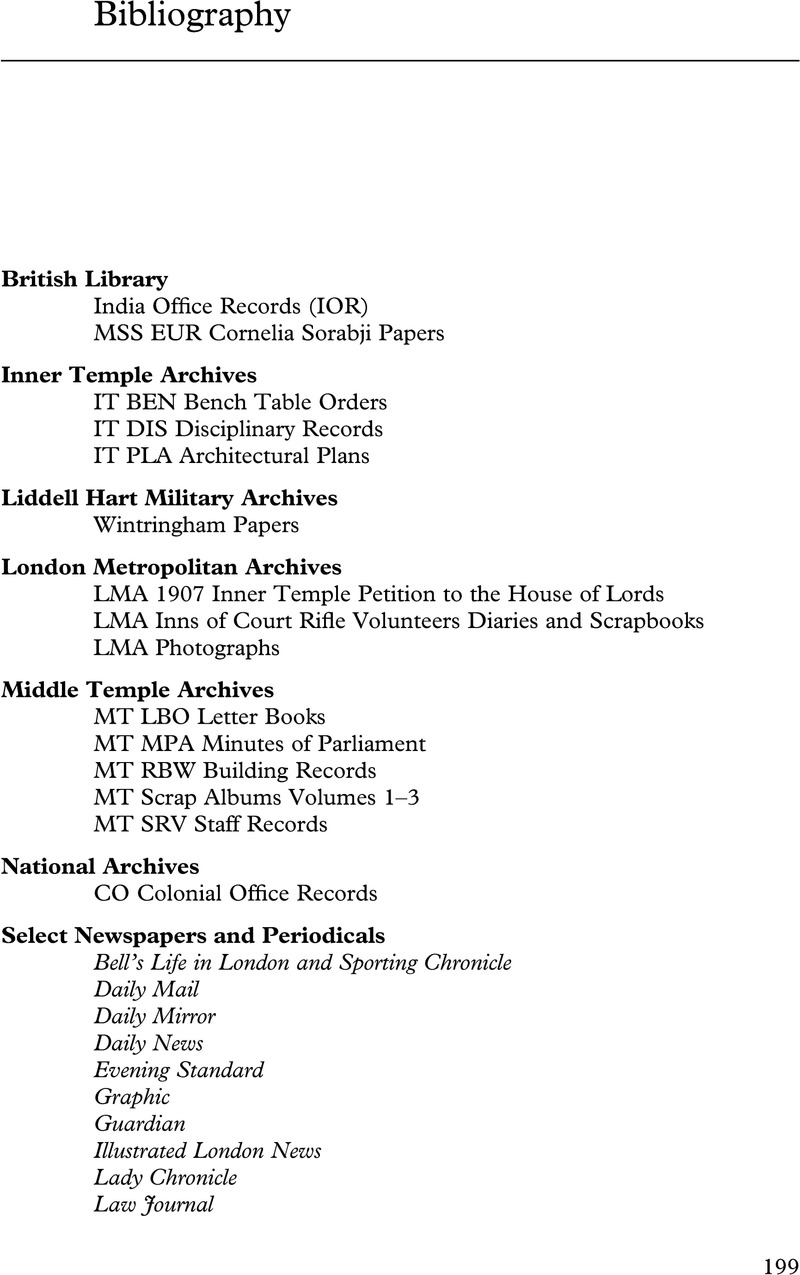Book contents
- Brotherhood of Barristers
- Modern British Histories
- Brotherhood of Barristers
- Copyright page
- Dedication
- Contents
- Figures
- Preface: A Primer on the Bar
- Acknowledgments
- 1 Introduction
- 2 The Metropolitan Inns
- 3 The Culture of the Bar
- 4 Gentlemanliness, Etiquette, and Discipline
- 5 Overseas Students
- 6 Women and the Bar
- Epilogue
- Bibliography
- Index
- References
Bibliography
Published online by Cambridge University Press: 11 April 2024
- Brotherhood of Barristers
- Modern British Histories
- Brotherhood of Barristers
- Copyright page
- Dedication
- Contents
- Figures
- Preface: A Primer on the Bar
- Acknowledgments
- 1 Introduction
- 2 The Metropolitan Inns
- 3 The Culture of the Bar
- 4 Gentlemanliness, Etiquette, and Discipline
- 5 Overseas Students
- 6 Women and the Bar
- Epilogue
- Bibliography
- Index
- References
Summary

- Type
- Chapter
- Information
- Brotherhood of BarristersA Cultural History of the British Legal Profession, 1840–1940, pp. 199 - 212Publisher: Cambridge University PressPrint publication year: 2024
References
Bibliography
British Library
India Office Records (IOR)
MSS EUR Cornelia Sorabji Papers
Inner Temple Archives
IT BEN Bench Table Orders
IT DIS Disciplinary Records
IT PLA Architectural Plans
Liddell Hart Military Archives
Wintringham Papers
London Metropolitan Archives
LMA 1907 Inner Temple Petition to the House of Lords
LMA Inns of Court Rifle Volunteers Diaries and Scrapbooks
LMA Photographs
Middle Temple Archives
MT LBO Letter Books
MT MPA Minutes of Parliament
MT RBW Building Records
MT Scrap Albums Volumes 1–3
MT SRV Staff Records
National Archives
CO Colonial Office Records
Select Newspapers and Periodicals
Bell’s Life in London and Sporting Chronicle
Daily Mail
Daily Mirror
Daily News
Evening Standard
Graphic
Guardian
Illustrated London News
Lady Chronicle
Law Journal
Law Times
Lloyd’s Weekly Newspaper
Morning Chronicle
Morning Post
Pall Mall Gazette
Punch, or the London Charivari
Times
Vote
Women’s Library
HLN Helena Normanton Papers
India Office Records (IOR)
MSS EUR Cornelia Sorabji Papers
IT BEN Bench Table Orders
IT DIS Disciplinary Records
IT PLA Architectural Plans
Wintringham Papers
LMA 1907 Inner Temple Petition to the House of Lords
LMA Inns of Court Rifle Volunteers Diaries and Scrapbooks
LMA Photographs
MT LBO Letter Books
MT MPA Minutes of Parliament
MT RBW Building Records
MT Scrap Albums Volumes 1–3
MT SRV Staff Records
CO Colonial Office Records
Bell’s Life in London and Sporting Chronicle
Daily Mail
Daily Mirror
Daily News
Evening Standard
Graphic
Guardian
Illustrated London News
Lady Chronicle
Law Journal
Law Times
Lloyd’s Weekly Newspaper
Morning Chronicle
Morning Post
Pall Mall Gazette
Punch, or the London Charivari
Times
Vote
HLN Helena Normanton Papers

